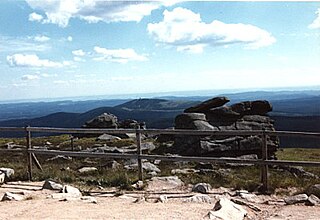
Harz National Park is a nature reserve in the German federal states of Lower Saxony and Saxony-Anhalt. It comprises portions of the western Harz mountain range, extending from Herzberg and Bad Lauterberg at the southern edge to Bad Harzburg and Ilsenburg on the northern slopes. 95 % of the area is covered with forests, mainly with spruce and beech woods, including several bogs, granite rocks and creeks. The park is part of the Natura 2000 network of the European Union.
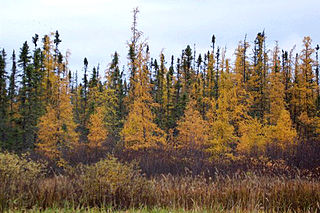
Larix laricina, commonly known as the tamarack, hackmatack, eastern larch, black larch, red larch, or American larch, is a species of larch native to Canada, from eastern Yukon and Inuvik, Northwest Territories east to Newfoundland, and also south into the upper northeastern United States from Minnesota to Cranesville Swamp, West Virginia; there is also an isolated population in central Alaska. The word akemantak is an Algonquian name for the species and means "wood used for snowshoes".

A bark beetle is one of about 6,000 species in 247 genera of beetles in the subfamily Scolytinae. Previously, this was considered a distinct family (Scolytidae), but is now understood to be a specialized clade of the "true weevil" family (Curculionidae). Although the term "bark beetle" refers to the fact that many species feed in the inner bark (phloem) layer of trees, the subfamily also has many species with other lifestyles, including some that bore into wood, feed in fruit and seeds, or tunnel into herbaceous plants. Well-known species are members of the type genus Scolytus, namely the European elm bark beetle S. multistriatus and the large elm bark beetle S. scolytus, which like the American elm bark beetle Hylurgopinus rufipes, transmit Dutch elm disease fungi (Ophiostoma). The mountain pine beetle Dendroctonus ponderosae, southern pine beetle Dendroctonus frontalis, and their near relatives are major pests of conifer forests in North America. A similarly aggressive species in Europe is the spruce ips Ips typographus. A tiny bark beetle, the coffee berry borer, Hypothenemus hampei is a major pest on coffee plantations around the world.

Picea engelmannii, with common names Engelmann spruce, white spruce, mountain spruce, or silver spruce, is a species of spruce native to western North America, from central British Columbia and southwest Alberta, southwest to northern California and southeast to Arizona and New Mexico; there are also two isolated populations in northern Mexico. It is mostly a high altitude mountain tree, growing at 900 metres (3,000 ft) – 3,650 metres (11,980 ft) altitude, rarely lower in the northwest of the range; in many areas it reaches the alpine tree line.

The blue spruce, also commonly known as green spruce, white spruce, Colorado spruce, or Colorado blue spruce, is a species of spruce tree. It is native to North America, and is found in USDA growing zones 1 through 7. It is found naturally in Arizona, Colorado, Idaho, New Mexico, Utah and Wyoming. It has been widely introduced elsewhere and is used as an ornamental tree in many places far beyond its native range. The blue spruce has blue-green colored needles and is a coniferous tree.

White spruce is a common name for several species of spruce (Picea) and may refer to:
Elm bark beetle is a common name for several insects and may refer to:

The ant beetle, also known as the European red-bellied clerid, is a medium size insect, rather soft-bodied, with strong mandibles that can tear between the hard sclerotized integument of bark beetles. Larvae and adults are common predators of bark beetles in Europe.
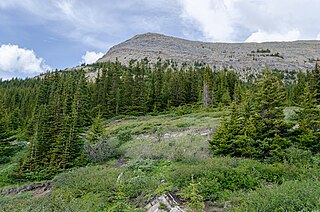
Fir and spruce forests are greatly affected by slight fluctuations in climate. Temperature is the primary determinate for spatial patterns of fir and spruce. The two dominant trees in this type of forest are Picea engelmannii and Abies lasiocarpa. Although thick-barked trees, such as the Pinus resinosa, frequently survive fire, the thin bark of spruce make them more vulnerable. Trees such as the Douglas fir withstand much of the fire due to the thicker bark they have. The scale of the burn mosaic during a fire, relative to species niche requirements and mobility, can have major impacts on flora and fauna dynamics.

Dendroctonus is a genus of bark beetles. It includes several species notorious for destroying trees in the forests of North America. The genus has a symbiotic relationship with many different yeasts, particularly those in the genera Candida (fungus) and Pichia that aid in digestion and pheromone production.

A pheromone trap is a type of insect trap that uses pheromones to lure insects. Sex pheromones and aggregating pheromones are the most common types used. A pheromone-impregnated lure, as the red rubber septa in the picture, is encased in a conventional trap such as a bottle trap, Delta trap, water-pan trap, or funnel trap. Pheromone traps are used both to count insect populations by sampling, and to trap pests such as clothes moths to destroy them.

Dendroctonus rufipennis, the spruce beetle, is a species of bark beetle native to British Columbia, Newfoundland and Labrador, Nova Scotia, Ontario, Quebec, Northern Manitoba, the Yukon, Colorado, Wyoming, Montana, and Maine. They are known to destroy forests of spruce trees including Engelmann, White, Sitka, and Colorado blue spruce. Adults average 4 to 7 mm in length.

The European spruce bark beetle, is a species of beetle in the weevil subfamily Scolytinae, the bark beetles, and is found from Europe to Asia Minor and some parts of Africa.

Tetropium fuscum, the brown spruce longhorn beetle, is a species of beetle in the family Cerambycidae. It was described by Johan Christian Fabricius in 1787. Tetropium fuscum is native to Europe and Northern Asia, and has been introduced to Nova Scotia, Canada. Brown spruce longhorn is a pest of spruce trees.

Hylastes ater is a species of beetle in the family Curculionidae, the true weevils. It is a bark beetle, a member of the subfamily Scolytinae. Its common name is the black pine bark beetle. It is native to Europe and parts of Asia, including China and Korea. It is known as an introduced species in many other regions, including Australia, New Zealand, the Americas, and South Africa. It is a pest of pines and other trees, and it is widespread in areas where pine trees are cultivated. The species "is an important threat to the biosecurity of all forested countries."

Ips is a genus of beetles in the family Curculionidae, the true weevils. They are bark beetles, members of the subfamily Scolytinae. Species are distributed throughout the Northern Hemisphere. Some are known as introduced species in Australia and Africa. Many species are pests of forest trees, especially pines and spruces. They are known commonly as engraver beetles, ips engraver beetles, and pine engravers.
The foamy bark canker is a disease affecting oak trees in California caused by the fungus Geosmithia pallida and spread by the Western oak bark beetle. This disease is only seen through the symbiosis of the bark beetles and the fungal pathogen. The bark beetles target oak trees and bore holes through the peridermal tissues, making tunnels within the phloem. The fungal spores are brought into these tunnels by the beetles and begin to colonize the damaged cells inside the tunnels. Symptoms of the developing fungus include wet discoloration seeping from the beetle entry holes as the fungus begins to consume phloem and likely other tissues. If bark is removed, necrosis of the phloem can be observed surrounding the entry hole(s). As the disease progresses, a reddish sap and foamy liquid oozes from entry holes, thus giving the disease the name Foamy bark canker. Eventually after the disease has progressed, the tree dies. This disease is important because of its detrimental effects on oak trees and its ability to spread to several new Californian counties in just a couple years.
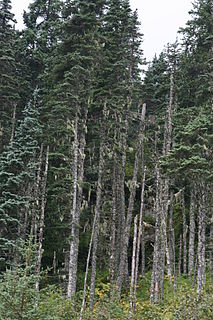
Picea × lutzii is a hybrid spruce tree that is a natural cross between white spruce and Sitka spruce occurring where the ranges of the two species overlap in coastal south-central Alaska and coastal British Columbia. Its common name is Lutz spruce. Its morphology is intermediate between the two parent species, the maritime Sitka spruce and the white spruce of dryer climates further inland. In addition to the parent spruces it shares its ecosystem with Tsuga heterophylla and T. mertensiana. The tree was named for Harold John Lutz, a scientist who specialized in forest soils and worked briefly for the United States Forest Service in Alaska where he collected the material used to describe the hybrid. A Lutz spruce from Alaska's Chugach National Forest was selected in 2015 for the Capitol Christmas Tree. This is the first Capitol Tree that has come from the state of Alaska.
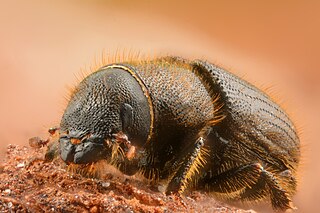
Dendroctonus micans, the great spruce bark beetle, is a species of bark beetle native to the coniferous forests of Europe and Asia. The beetles burrow into the bark of spruce trees and lay eggs which develop into larvae that feed on the woody layers under the bark.

Dendroctonus terebrans, the black turpentine beetle, is a species of bark beetle native to the eastern United States. Its larvae tunnel under the bark of pine trees, weakening and sometimes killing the trees.
















